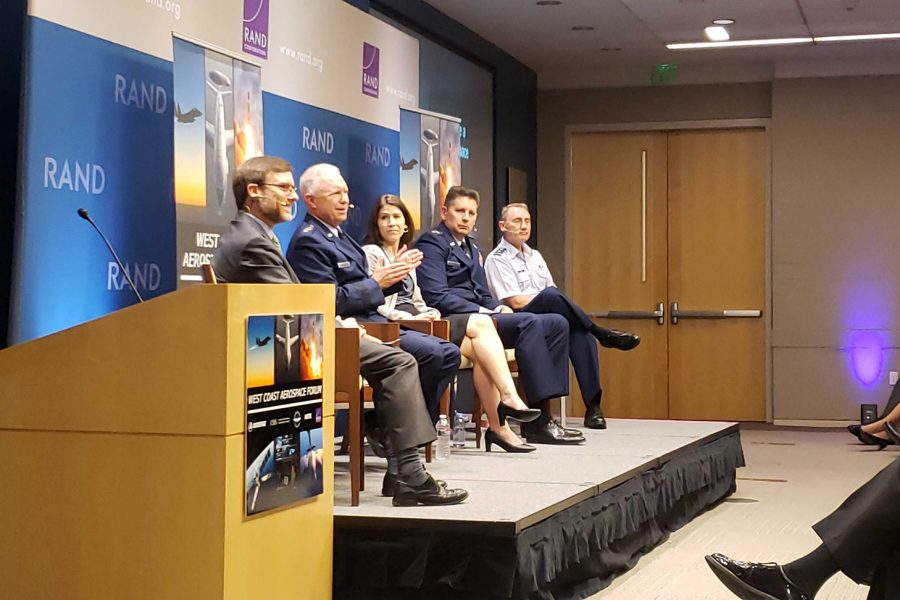The architects and initial leaders of the prospective Space Force need to ensure it is immediately ready to be an equal among established military branches, while the formation of the new service should be used as a way to shake up established acquisition processes, top USAF officials said.
“The US Space Force has got to be effective inside the national security environment on Day One, “ Lt. Gen. David Thompson, the vice commander of Air Force Space Command, said Dec. 6 at the West Coast Aerospace Forum in Santa Monica, Calif. The forum is sponsored by AFA’s Mitchell Institute, RAND Corp., Mitre Aerospace Corp, and the Center for Strategic and International Studies. “It will be smaller than the other forces … it will be a light weight in a ring full of sumo wrestlers.”
House and Senate negotiators are still hung up on finalizing the Fiscal 2020 National Defense Authorization Act, which is expected to create the Space Force. While the exact way forward is yet to be announced, top USAF space officials said the fact that the process has progressed this far shows the country is taking seriously the importance of space in future military operations.
“The world has changed, space is now a war-fighting domain,” said Maj. Gen. Clint Crosier, the director of the Space Force Planning Task Force. While the US has historically avoided militarizing space, the “enemy gets a vote” and other countries have operationalized the domain, which potentially hold at risk about $19 trillion and more of international commerce that relies on space communications, he said. Additionally, nearly every concept of US military multi-domain command and control relies either directly or indirectly on space.
By moving space operations out of the Air Force, where it is one of 12 missions handled by one service with one Chief of Staff, a new Title 10 branch can focus more intensely on operations in that realm. A new Space Force will develop the doctrine, concepts, training, and tactics, techniques and procedures that will be required. “A cadre of people will grow up and spend their careers growing, thinking about how we dogfight in space,” Crosier said. “We will get there in the future, we aren’t far away from that now.”
Once Congress approves the creation of the service, leaders need to prioritize what needs to be addressed immediately. For example, the new uniforms and ranks of the service aren’t important to those who will be serving in the Space Force, Thompson said.
“To them, it doesn’t really matter if they show up on Day One in a different uniform,” he said. “Really it’s: Don’t try and change things that don’t need to be changed, and ensure you are adapting to things you need to adapt to.”
The biggest avenue of opportunity in creating the new service is the chance to break long-held traditions of acquisition that have lead to expensive programs that can take extended periods of time to create, the officials said.
For example, the House-passed NDAA includes language stating the Space Force should have authorities to create alternative acquisition processes and systems aimed at “going fast.” If passed, this language would be a possible step to ensure relief from the broader Pentagon acquisition system, Crosier said.
“Now is the time to consider alternative models to acquisition,” said Lt. Gen. John Thompson, the commander of the Space and Missile Systems Center, adding that the shift away from traditional methods shouldn’t be confined to just a new military service. The Air Force should make changes as well, he said.
If the Space Force doesn’t have a new approach to acquisition, it will “continue to struggle with slow programs, expensive programs, with architectures that are not effectively … organized,” said US Space Command’s Thompson.
The new service also has an opportunity to take a different approach to personnel, said Margaux Hoar, the research program director of the organizations roles and missions program at CNA. The Space Force needs to have “permeability” between its Active and Reserve components, giving the opportunity for personnel to quickly and easily “on-ramp and off-ramp” between the two. This gives personnel the chance to serve in civilian roles at startups and relevant industry positions, which can then help bring in new ideas and a different culture to the service, she said.


